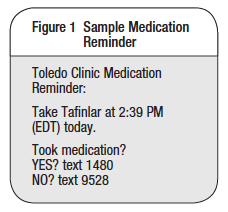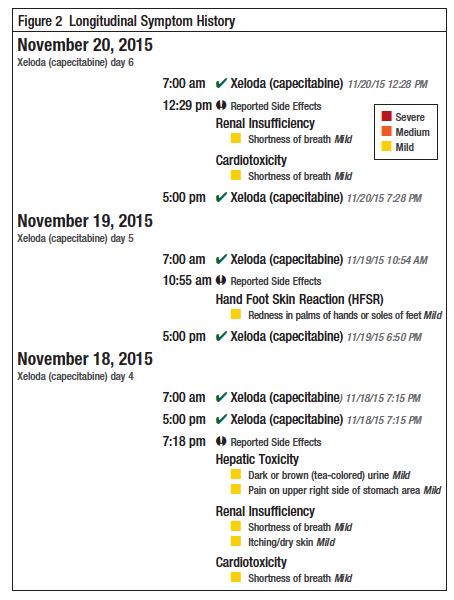In the fourth quarter of 2014, Toledo Clinic Cancer Centers started an in-office dispensary. The dispensary is staffed by 2 individuals, Elaine Neitzel and Tasha Dove, LPN. They are responsible for dispensing oral medication orders, including oral chemotherapy. In addition to their drug ordering and dispensing responsibilities, they obtain prior authorizations, submit patient assistance applications, and coordinate prescriptions with specialty pharmacies, as needed. They also maintain communication with patients regarding adherence to the regimen and evaluation of side effects.
These care coordination responsibilities are an important part of the dispensary service. It is labor-intensive and dependent on the staff initiating contact with the patient. Finding a technology-based solution to maintaining contact with the patient to track adherence as well as to manage side effects is important for a busy dispensary.
Patient–Practice Relationship
Care coordination and management are critical components of the ongoing relationship between an oncology practice and its patients. The importance of this relationship is evident in the various oncology medical home programs sponsored by payers, as well as in the standards for the Quality Oncology Practice Initiative (QOPI) certification and in other quality practice standards.
For the Toledo Clinic Cancer Centers, this relationship has evolved over time as needs have changed. In the past few years, the practice has completed the QOPI certification process for initial certification and for recertification.1 In addition, the practice has completed the requirements for level 3 certification as a Patient-Centered Specialty Practice.2
The practice has submitted an application to the Center for Medicare and Medicaid Innovation and identified a strategy for care coordination related to oral chemotherapy compliance, using phone calls at specified intervals; since the application was submitted, however, a technology option presented itself. “Text interventions are feasible in patients with cancer prescribed OAs [oral anticancer agents] for symptom management and medication adherence,” according to one study.3
The WorkUp Platform, provided by WorkUp, provides 2-way communication with patients who are receiving oral chemotherapy. The platform sends reminders to the patient’s smartphone, and offers an opportunity for the patient to record any side effects. The message is then communicated to the practice.
This article describes the process used by our practice to evaluate the platform, the development of the text used for communication, and the implementation strategy. The staff in the practice’s dispensary was involved in evaluating the platform, and worked with the first patient to perfect the use of this technology for care coordination of patients receiving oral chemotherapy.
Evaluating the WorkUp Platform
In August 2015, Kenny Engels, Co-founder and Chief Executive of WorkUp, Inc, demonstrated to the clinic how the WorkUp Platform works. Several benefits were immediately evident, including the opportunity to communicate directly with the patient, the patient’s ability to report any side effects, and the clinic’s ability to monitor the remaining doses of a medication. The app provides an opportunity to coordinate care and an easy way to reorder medications when the patient’s supply was getting low.
Knowing when to reorder a patient’s medication had been a problem for the dispensary staff. Patients often forgot to call and reorder their medication when their supply was low. Often, the patient would call, stating that he or she had taken the last pill and was planning to come in to pick up the next prescription that day; however, these drugs are not kept on the shelf in the dispensary.
Treatment continuity is disrupted when a patient waits for the order to be processed and received from the wholesaler. With the app, however, the dispensary staff receives information on the number of doses remaining, and knows when to reorder the drug for the patient. This is a nice, unexpected benefit that provides improved continuity of care.
One concern was the ability of older patients to understand and use the app. The use of a smartphone may be a problem for some patients. One benefit of the platform is that it is also accessible via computer. So patients who have difficulty using a smartphone can use their computer to receive the messages and update the information. Patients using iPads and tablets can also access the app.
We decided that the platform had a role in the dispensary. The next step was to evaluate the HIPAA compliance issues. Information about the platform and our intended use was sent to the compliance officer and an attorney for review. A demonstration of the system was completed, and the compliance officer and the attorney signed off on the project. The final approval from the physicians was also obtained. We were ready to begin. The service agreement and the business associate agreement were signed in September 2015.
Development of Scripts
According to Mr Engels, the use of the platform is broken into 2 parts. The first part is the creation of reminders specific to the drug the patient is taking. Patients are provided information and instruction regarding the platform, and are assisted with loading the app on their smartphone. Once the app is activated and the patient starts taking the medication, the reminder process starts (Figure 1).
The second part is the symptom report process (Figure 2). The patient uses the app to send information about any symptoms he or she is having, and a phone call is no longer required. Secure messages from the patient are sent to the designated provider. The app translates the patient’s report of “I’m short of breath” into the actual side-effect description of “dyspnea.” The system also provides a longitudinal picture of the symptom history to assist in assessing the patient quickly.
The grade of the report or the symptom can suggest the need for an office visit. This type of communication is available 24 hours a day, 7 days a week, meeting the requirements of oncology medical homes and other value-based models.
Implementation Strategy
The final step was to identify patients who would be good candidates to pilot the platform. The WorkUp app provided a simple, frequently asked questions sheet for the staff to use to introduce the app to potential candidates. The sheet describes how to introduce the program to patients and lists the most common questions.
The first patient who was invited to participate in the pilot and the patient’s spouse are technically savvy, and they were very interested in using the platform. WorkUp worked with the dispensary staff to set the patient up and to provide training on using the app. As more patients take advantage of the platform, the dispensary staff will be trained to complete this process.
Much time was spent on developing a message to respond to the patient’s report of a side effect. The first obstacle that had to be overcome was access to the app. We needed assistance from the information technology team to address issues related to Google Chrome and Internet Explorer.
Once those were overcome, we were able to log in to the WorkUp app as a test patient and enter a side-effect report. The message was reviewed and revised by nurse practitioners and triage staff. Depending on the severity of the symptom, 1 of 2 messages was sent to the patient (Figure 3).
The messages have since been modified to include instructions for the patient to call the after-hours service so they could speak directly with the on-call physician. The patient is provided guidance, and the practice receives information from the patient regarding the specific side effect(s) (Figure 4).
It took approximately 4 months from the initial discussions to being ready to set up the first patient. However, right before we were ready to go live with the app, the clinical picture of the patient changed, and his oral chemotherapy was stopped. The staff searched for another good candidate for the pilot but did not find anyone who was receiving oral chemotherapy. A few months later, the first patient was again using oral chemotherapy and was quickly set up with the app. The pilot is going well, with few problems.
Conclusion
The use of technology to provide continuous communication with patients using oral chemotherapy is now available and can be used to monitor patient adherence. The use of the WorkUp Platform is an option for practices to use to meet the 3 important patient care goals of continuity of care, around-the-clock access to the practice by patients, and documentation of adherence to the treatment protocol when oral chemotherapy is used.
References
- Quality Oncology Practice Initiative, American Society of Clinical Oncology. Standard 18. In: QOPI Certification Site Assessment Standards: 2014-2015. www.instituteforquality.org/sites/instituteforquality.org/files/QOPI%20Certification%20Program%20Stan dards.docx.pdf. Accessed April 2, 2016.
- National Committee for Quality Assurance. PCSP 2: provide access and communication. In: Standards and guidelines for PCSP 2013 recognition. March 28, 2016. http://store.ncqa.org/index.php/2013-pcsp-standards-and-guidelines-epub-single-user.html. Accessed April 2, 2016.
- Spoelstra SL, Given CW, Sikorskii A, et al. Feasibility of a text messaging intervention to promote self-management for patients prescribed oral anticancer agents. Oncol Nurs Forum. 2015;42:647-657.






